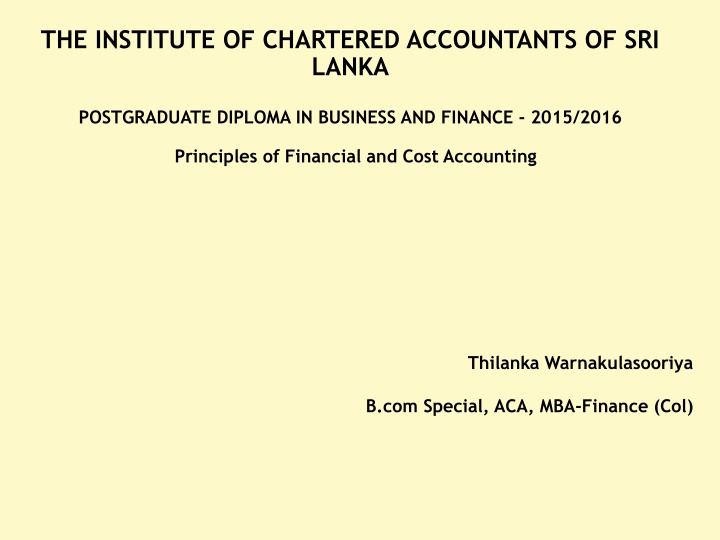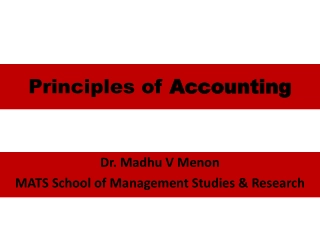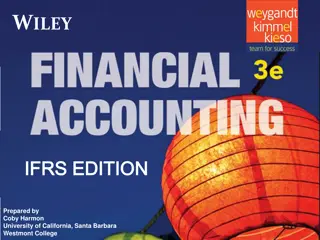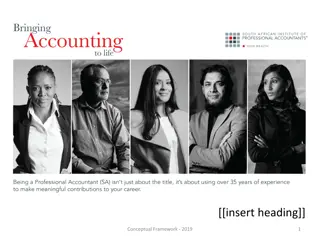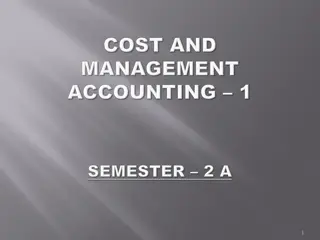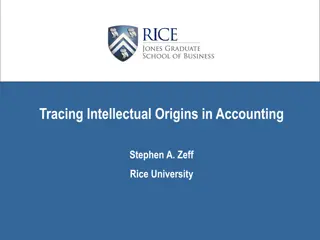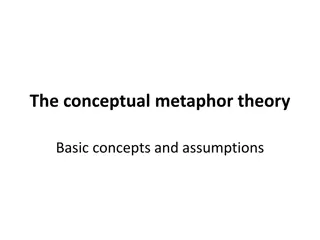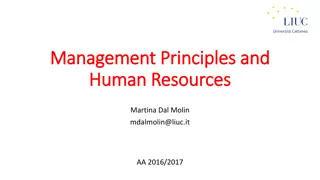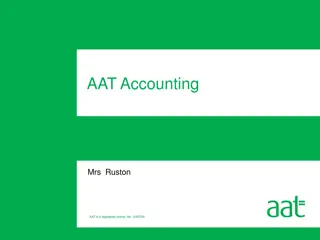Principles of Financial and Cost Accounting - Conceptual Framework for Financial Reporting
This content explores the principles of financial and cost accounting along with the conceptual framework for financial reporting, covering topics such as the need for a conceptual framework, objectives of financial reporting, qualitative characteristics of financial information, and more.
Download Presentation

Please find below an Image/Link to download the presentation.
The content on the website is provided AS IS for your information and personal use only. It may not be sold, licensed, or shared on other websites without obtaining consent from the author.If you encounter any issues during the download, it is possible that the publisher has removed the file from their server.
You are allowed to download the files provided on this website for personal or commercial use, subject to the condition that they are used lawfully. All files are the property of their respective owners.
The content on the website is provided AS IS for your information and personal use only. It may not be sold, licensed, or shared on other websites without obtaining consent from the author.
E N D
Presentation Transcript
THE INSTITUTE OF CHARTERED ACCOUNTANTS OF SRI LANKA POSTGRADUATE DIPLOMA IN BUSINESS AND FINANCE - 2015/2016 Principles of Financial and Cost Accounting Thilanka Warnakulasooriya B.com Special, ACA, MBA-Finance (Col)
Conceptual Framework for the Preparation and Presentation of Financial Statements
Learning Outcomes At the end of this session the students should be able to: Understand the need for conceptual framework for financial reporting Understand the objective of financial reporting Understand the fundamental assumptions in FR Describe the qualitative characteristics of financial information Define the elements of financial statements Understand the components statements of financial
What is a conceptual framework? A conceptual framework is a coherent system of inter-related fundamentals that can lead to consistent standards and that prescribes the nature, function, limits of financial accounting and financial statements. (FASB Definition) objectives and 4
Objectives of the Framework To assist in the development of A/S and review of existing standards. To assist in promoting harmonization of regulation, Accounting Standards and procedures relating to Financial Reporting To assist preparers of Financial Statements in applying accounting standards To assist auditors in forming an opinion To solve new practical accounting problems quickly. To increase financial understanding and confidence in financial reporting. To enhance, comparability among companies Financial Statements. 1. 2. 3. 4. 5. statements users 6. 7. 5
The matters dealt within the Framework The objectives of financial statements Underlying assumptions Qualitative characteristics of F/S The elements of F/S The definition and recognition of the elements of F/S Measurement of the elements of the F/S Concepts of capital and capital maintenance 6
The Objective of Financial Reporting Provide financial information about the reporting entity that is useful to existing and potential investors and other creditors in making decisions about providing resources to the entity . Financial statements prepared for this purpose meet the common needs of most users who don t have the right to demand information and who have a reasonable knowledge of business and economic activities Financial statements also show the results of the stewardship of management or the accountability of management. 7
Underlying Assumptions Accrual Basis In order to meet the objectives, financial statements are prepared on the accrual basis of accounting. What is accrual basis of accounting? What is cash basis? Effects of transactions and other events are recognised when they occur ( not when cash or cash equivalents received or paid) 9
Underlying Assumptions Going Concern The prepared on the assumption that an enterprise is a going concern and will continue in operation for the foreseeable future. financial statements are normally Hence it is assumed that the entity has neither the intention nor the need to liquidate or curtail materially the scale of its operations. 10
Qualitative Characteristics Primary Qualitative Characteristics of Accounting Information Relevance : Capable of making a difference in users decision Information should have the predictive value (predictive role), Feedback value (Confirmatory role). Faithfully represent /Reliability: Financial reports represent economic phenomena in words and numbers. To be useful, financial information must not only represent relevant phenomena, but it must also faithfully represent the phenomena that it purports to represent. To be a perfectly faithful representation, a depiction would have three characteristics. It would be complete, neutral and free from error. Completeness Neutrality (unbiased) Free from errors 11
Qualitative Characteristics Enhancing Qualitative Characteristics Comparability: information should be presented in a manner that can be compared with the historical information of the same organization, information of the other competitive organizations, information with the industry average figures. Verifiability knowledgeable and independent observers could reach consensus Materiality Information is material if omitting it or misstating it could influence decisions that users make on the basis of financial information about a specific reporting entity. Understandability: information should be presented in a manner that can be easily understood by an average man who is having a general idea about business Timeliness Timeliness means having information available to decision-makers in time to be capable of influencing their decisions. Generally, the older the information is the less useful it is. 12
Elements of Financial Statements There are five elements in the Financial Statements. Assets Liabilities Equity Income Expenses 13
ELEMENTS OF FINANCIAL STATEMENTS ASSETS. A resource controlled by the entity as a result of past events and from which future economic benefits are expected to flow to the entity. Main features Controlled by the enterprise Past Events Future economic benefits 14
ELEMENTS OF FINANCIAL STATEMENTS LIABILITIES A present obligation of the entity arising from past events, the settlement of which is expected to result in an outflow from the entity of resources embodying economic benefits. Main features Present obligations Transfer economic benefits Past Transactions or Events 15
Elements of Financial Statements INCOME. accounting period in the form of inflows or enhancements of assets or decreases of liabilities that result in increases in equity, other than those relating to contributions from equity participants. Income is increases in economic benefits during the EXPENSES. Expenses are decreases in economic benefits during the accounting period in the form of outflows or depletions of assets or incurrences of liabilities that result in decreases in equity, other than those relating to distributions to equity participants. 16
ELEMENTS OF FINANCIAL STATEMENTS EQUITY. The residual interest in the assets of the enterprise after deducting all its liabilities. 17
Components of Financial Statements Statement of Financial Position Income Statement Statement of Comprehensive Income (including other Comprehensive Income) Statement of Changes in Equity Statement of Cash flows Notes 18
Statement of Financial Position XYZ Group Statement of Financial position as at 31 December 2013 31 Dec 2013 31 Dec 2012 ASSETS Non-current assets Property, Plant and equipment Goodwill Other intangible assets Investments in associates Financial assets Total non-current assets Current Assets Inventories Trade receivables Other current assets Cash and cash equivalents Total current assets Total assets x x x x x x x x x x x x x x x x x x x x x x xx xx 19 Continued
Statement of Financial Position 31 Dec 2013 31 Dec 2012 EQUITY AND LIABILITIES Equity attributable to owners of the parent Stated capital Retained earnings Other components of equity x x x x x x x x x X x x Non-controlling interest Total equity Non current liabilities Long term borrowings Deferred tax Long term provision s Total non-current liabilities x x x x x x x x Continued . 20
Statement of Financial Position Current liability Trade and other payables Short-term borrowings Current portion of long term borrowing Current tax payable Short-term provisions Total current liabilities Total liabilities Total equity and liabilities x x x x x x x x x x x x x x xx xx 21
Statement of Comprehensive Income 2013 x (x) 2012 x (x) Revenue Cost of sales Gross profit x x Other income Distribution costs Administrative expenses Other expenses Finance costs Share of profit of associates Profit before tax Income tax expense Profit for the year from continuing operations Loss for the year from discontinued operations PROFIT FOR THE YEAR x x x x x x x x x x x x x x (x) x (x) x - (x) x x Continued . 22
Statement of Comprehensive Income 2013 x 2012 x PROFIT FOR THE YEAR Other comprehensive income: Exchange differences on translating foreign operations Investments in equity instruments Cash flow hedges Gains on property revaluation Actuarial gains (losses) on defined benefit pension plans Share of other comprehensive income of associates Income tax relating to components of other comprehensive income Other comprehensive income for the year, net of tax TOTLA COMPREHENSIVE INCOME FOR THE YEAR x x x x (x) x (x) (x) x x x (x) x (x) (x) x x x Continued . 23
Statement of comprehensive income 2013 2012 TOTAL COMPREHENSIVE INCOME FOR THE YEAR Profit attributable to Owners of the parent Non-controlling interest x x x x x x x x Total comprehensive income attributable to: Owners of the parent Non-controlling interest x x x x x x Earnings per share (in currency units) Basic EPS Diluted EPS x x x x 24
XYZ Group Statement of changes in equity for the year ended 31 December 2013 S.capital Retained earnings Translati on of foreign operatio ns Inve. in equity instru. Cash flow hedges Revalu ation surplu s Total N C I Total Equity Balance at 1 Jan 2012 x x x x x x x x x - (x) Changes in accounting policy Restated balance x x x x x x x x x Changes in equity for 2012 Dividends Total Comprehensive Income for the year Balance at 31 Dec 2012 x x x x x x x x x Changes in equity for 2013 Issues of share capital Dividend Total comprehensive income for the year x x x x x x x x Transfer to retained earnings Balance at 31 Dec 2013 x x x x x x x x x 25
